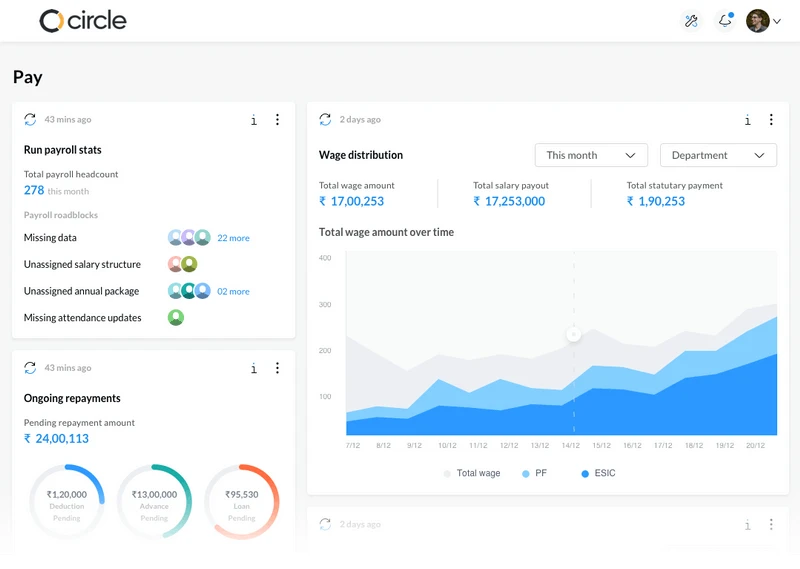The most efficient workplace is the one that considers certain metrics for its effective and smooth workflow. One of the most essential workplace metrics is employee turnover. It indicates the happiness and employee satisfaction levels with the work environment and the managers.
Turnover is the calculation of the number of employees that leave their jobs in a given period. It does not include promotion but takes into consideration retirement. While voluntary turnover is when the employees decide to leave, involuntary turnover is when the manager or the boss decides to let go of an employee.
In this article, we will read in detail everything about employee turnover and how reducing it can save a lot of cost for your organisation!
What is Employee Turnover Rate?
The rate at which employees leave the organisation is known as the employee turnover rate. While a low turnover rate implies that the organisational culture and the workplace are healthy and productive, a high turnover rate indicates that the organisation must take measures to improve the facilities and amenities given to the employees to make them stay.
High turnover can be disruptive to the business and pave the way for additional costs and expenditures. Therefore, companies must avoid employee turnover by creating employee retention strategies focusing on employee satisfaction and engagement.
To calculate the employee turnover rate, organisations must divide the number of employees leaving their position in a given period, by the total number of employees in that period. If 10 employees leave the company in a year, and the total number of employees in the company that year is 100, the employee turnover rate will be 10%. Generally, businesses calculate this rate on a monthly basis to understand how well their organisation is doing.
Effects of Employee Turnover on a Company
Employee turnover has fiscal as well as value costs attached to it. On one hand, it makes you pay for the new hiring you will have to conduct to fill up the empty position, and on the other hand, it can affect the mindset of fellow employees, influencing them to take similar steps. This creates a hostile environment in the organisation, and can even lead to more staff turnover. Let us discuss the possible effects of employee turnover on a company.
- Lessened Productivity
The company has to hire new employees for the vacant position, which often takes a lot of time to catch up to the speed and expertise of the existing employees. This causes a loss of productivity of the team and the team lags behind. This also adds strain to the existing staff and even calls for delaying the planned projects sometimes.
- Financial Losses
The cost of employee turnover in the company is generally 1.5-2 times the salary of the employee. This includes mainly the cost that occurred due to the delayed projects and work, operating expenses and the costs incurred on recruitment and effective training.
- Negative Effect on Morale
High turnover rates have adverse effects on the manager and employee morale. The employees start feeling underappreciated and start highlighting the problems with the organisation. When qualified employees resign, the companies are unable to meet their goals due to the shortage of experienced workers, which has a negative effect on the morale of the team and brings frustration.
- Distorts the Company’s Image
A high turnover rate in a company poses a negative image of the company on the potential hires and the customers. Voluntary turnover indicates that the employees are not being remunerated adequately, and involuntary turnover might put a bad impression on the managers of the company. No customer or candidate wants to be a part of a company which is unstable and thus, it highly affects the overall image and growth of the company.
Advantages of Reducing Employee Turnover
When companies work hard for employee retention by offering their employee job satisfaction and reducing employee turnover, they are bestowed with several benefits. Some advantages of reducing employee turnover include the following-
- Consistency
While employee turnover causes disruption, employee retention in the organisation causes consistency. Retaining experienced employees in the company is quintessential to maintaining consistency and a smooth workflow. If they leave, you will have to search for a replacement, and the new hires will need time to get on the pace and provide the productivity level of an experienced employee.
- Reduced Cost
Replacing an employee is a costly process. You need to pay for advertisement, the hiring process and then the training costs of the new hires. Also, the firm will face time wastage while the new hire is getting all prepped up for the role. The loss of an experienced employee makes you face a loss of knowledge of your company and its working, and the new employee will make a lot of mistakes before getting to that level of perfection.
- Consistency in Customer Dealing
If your organisation demands a lot of customer dealing, your customers might get irritated if they have to start dealing with a new employee as the old ones resign. The relationship of the company with the client is hindered, as the ex-employee who dealt with the customer regularly was well-acquainted with the liking, purchase history and preferences of the client. Retaining your experienced employees will help you maintain familiar contacts with your customers, and keep them contented.
- Loyal Employees
By inculcating practices for employee engagement and employee retention, you can ensure that the workforce of your organisation is satisfied with the organisation. This eliminates the spread of bad word of mouth in the organisation and the presence of unsatisfied clients, which can pose a negative effect on the productivity of the workers.
Also, with each employee leaving, the workload for the others increases, causing dissatisfaction and stress among them. On the contrary, having experienced and engaged employees who are engaged and satisfied, for a long time, increases their loyalty towards the organisation and improves productivity in the organisation.
Tips for Improving Employee Turnover
It is the duty of organisations to constantly engage with the employees and understand their state of mind and their perception of the organisation. It must identify the reasons behind employee turnover, and try to mitigate the problems faced by the employees through effective employee retention strategies. Mentioned below are a few tips which can help organisations improve their employee turnover.
- Build an Effective Recruitment Strategy
Hiring the right employees for the job is an essential step in reducing employee turnover. While taking the interviews, you must be upfront about the future plans and career path of the candidates, and must not entertain the candidates who seem informal or casual about the job. You should create accurate job descriptions to hire only the relevant employees in the hiring process. If your selected candidates resign within a few weeks after the training or do not make it to the training itself, you are probably hiring the wrong employees.
- Pay Attention to Employee Onboarding
The onboarding process is generally the first touchpoint of the employee with your company and poses a significant effect on the mind of the candidate regarding the company image and company culture. The first few weeks of the employee with your company is generally the period when they decide whether they want to convert into long-term employees or start seeking other opportunities. Thus, you must make them feel valued and appreciated from day 1, and bag their loyalty to ensure they do not back out too soon.
- Focus on Employee Feedback
Communication is indispensable for any organisation. The managers must learn to communicate with the employees regularly and acquire their feedback on varying issues. Through meetings and employee surveys, you must gain insight into the needs, concerns and problems of the staff. Some issues might include a lack of advancement opportunities, poor work-life balance, problems with the manager, etc. You must work on the feedback and adjust or create policies according to the feedback to make the employees feel that their voices are being heard and acted upon.
- Keep the Employees Engaged
To reduce staff turnover, you must ensure that your current employees feel valued, motivated and engaged in a positive work environment. You can encourage them to take up new projects and offer them career development opportunities.
Also, you must appreciate your employees for their efforts and recognise their good performance. You must also establish a link between the employees and the business goals and core values so that the employees can feel that they are an integral part of the organisation and significant for its overall growth and development.
- Review Your Benefit Schemes Regularly
You must review and modify the employee benefits and their salaries every now and then. Your employees must be rewarded for the extra effort they make, which adds up to the value of your company. Competitive pay and benefits can make employees feel valued and appreciated. With this, they stay engaged in your company and do not seek better opportunities somewhere else.
Final Thoughts
Employee turnover can be a termite for your company, and when it gains its pace, it eats up your organisation gradually. It brings with it a lot of unprecedented costs and expenditures- tangible as well as intangible. Therefore, you must ensure to stay away from this menace as much as possible. The company culture today is influential, and you can either keep your employees happy and make them stay, or you can disappoint them and force them to resign. If you prefer stability over constant change and instability in the organisation, you must start working on your employee engagement and employee retention strategies, to ensure that your staff turnover rate is as low as possible.
If you have any questions let me know in the comments below. Additionally if you’re looking for an HRMS with manage payroll software, attendance management & more. Book a demo with sumHR today.
FAQs
1. What is employee turnover?
The number of workers leaving a company in a certain period is known as employee turnover.
2. What are the reasons for employee turnover?
There are multiple reasons that cause employee turnover such as inefficient management, poor compensation, bad organisational culture, etc.
3. How can you reduce employee turnover?
You can reduce employee turnover by having a strong employee retention strategy with employee appreciation and rewarding plans.








